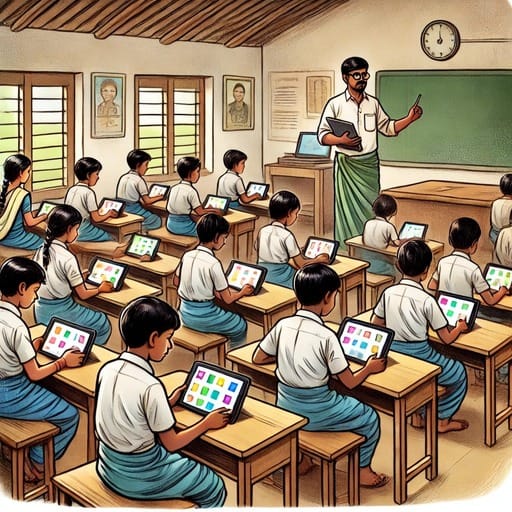The Importance of Digital Tools for Modern Schools in India

In today’s fast-evolving world, digital transformation has extended its influence into every sector, including education. In India, where the education system caters to a massive population, adopting digital tools has become a cornerstone for modern schools. These tools revolutionize how administrators, teachers, parents, and students interact with and access information, making education more efficient, inclusive, and accessible.

This blog post will outline the following points:
- Automation simplifies administrative tasks like fee collection, attendance, and communication.
- Interactive tools empower teachers to create engaging and inclusive learning experiences.
- Students benefit from personalized, accessible, and resource-rich digital learning platforms.
- Real-time updates and communication portals strengthen parent-school relationships.
- Digital tools bridge education gaps in rural areas and support students with special needs.
- Data analytics enable schools to improve outcomes and personalize teaching strategies.
- Infrastructure challenges can be addressed through partnerships, training, and government support.
- Embracing digital tools is key to delivering quality education in a rapidly evolving world.
Streamlining Administrative Processes
For school administrators, managing vast amounts of data can be daunting. Digital tools simplify administrative tasks by automating processes like fee collection, attendance tracking, and staff management. For example, a centralized digital system can streamline fee payments, allowing parents to pay online and receive instant receipts, while administrators can monitor transactions in real-time, reducing paperwork and errors. These platforms save time, reduce errors, and ensure smoother operations.

Moreover, digital platforms enable better communication within the school ecosystem. Notices, circulars, and updates can be shared instantly, eliminating delays and miscommunication. These tools enhance coordination, ensuring everyone is on the same page.
Enhancing Teaching and Learning
Teachers play a crucial role in shaping young minds and digital tools empower them with innovative methods to engage students. Interactive tools such as virtual simulations, digital storytelling platforms, and adaptive assessments allow teachers to present complex topics in a simplified and engaging manner. These resources also help cater to diverse learning styles, making the classroom experience more inclusive and effective. Smartboards, interactive lessons, and digital resources bring concepts to life, making learning more engaging and relatable. Teachers can access extensive online resources for lesson planning and adapt their teaching styles to diverse learning needs.

For students, digital tools open doors to a wealth of knowledge beyond traditional textbooks by complementing classroom learning. These tools provide interactive content, video explanations, and real-time problem-solving support, making complex concepts easier to grasp. They enhance traditional teaching by offering additional practice materials and opportunities for collaborative learning, fostering a more comprehensive educational experience. Personalized learning platforms allow them to study at their own pace, revisit challenging topics, and build critical skills like digital literacy, collaboration, and problem-solving. This ensures students are better prepared for the demands of a dynamic world.
Strengthening the Parent-School Relationship
Parents are key stakeholders in their children’s education, and digital tools are enhancing this relationship. Mobile apps and portals provide real-time updates on academic progress, attendance, and behavioral reports. Parents can communicate directly with teachers, ensuring timely feedback and fostering collaboration.

This transparency builds trust and helps create a supportive environment for students at home and in school. Parents remain informed and engaged, contributing to better educational outcomes.
Making Education Inclusive and Accessible
India’s diverse landscape poses challenges in ensuring quality education for all. Digital tools help bridge this gap by providing access to education in remote and underserved areas, such as rural villages in states like Bihar and Jharkhand, where traditional resources are scarce. These tools enable students in these regions to access high-quality learning materials and interactive lessons, significantly reducing the urban-rural education divide. Free digital resources in multiple languages make learning more accessible to a broader audience.

For students with special needs, assistive technologies like text-to-speech software and customized learning apps foster inclusivity. These tools empower every student to participate actively and thrive in mainstream education.
Data-Driven Decision Making
Digital tools provide schools with valuable data on student performance, attendance, and teacher effectiveness. By analyzing this data, schools can identify areas for improvement and implement targeted interventions. Early identification of struggling students allows for timely support, ensuring better outcomes.

Teachers can track progress and adjust their strategies based on real-time insights, creating a culture of continuous improvement and personalized learning.
Challenges and the Way Forward
While the benefits of digital tools are undeniable, their adoption in Indian schools faces challenges such as lack of infrastructure and digital literacy. To address these issues, schools need reliable internet access and affordable devices, which can be facilitated through public-private partnerships. Additionally, providing digital literacy training for teachers and students can ensure effective use of technology. Government initiatives like subsidized broadband for rural schools and workshops for educators can also play a crucial role in overcoming these barriers. Many rural schools struggle with limited access to electricity and internet connectivity.

To overcome these barriers, collaboration among the government, private sector, and educational institutions is essential. Investments in infrastructure, training, and support will ensure the benefits of digital transformation reach every corner of the country.
Conclusion
The integration of digital tools in modern schools is a necessity in today’s digital age. By making information accessible to administrators, teachers, parents, and students, these tools are transforming education into a more efficient and inclusive process. As India embraces digital transformation, the education sector has the opportunity to empower future generations with the skills and knowledge needed to thrive in a rapidly changing world.

For schools, the message is clear: embracing digital tools is key to delivering quality education and staying relevant. With the right approach, India’s schools can set a global benchmark in leveraging technology to create a brighter future for all.

